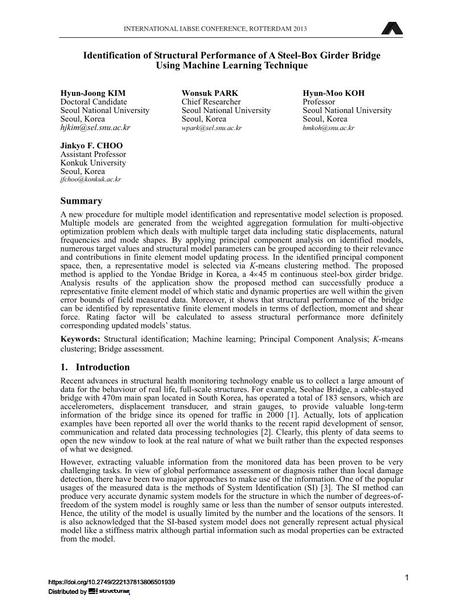Identification of Structural Performance of A Steel-Box Girder Bridge Using Machine Learning Technique

|
|
|||||||||||
Bibliographic Details
| Author(s): |
Hyun-Joong Kim
Wonsuk Park Hyun-Moo Koh Jinkyo F. Choo |
||||
|---|---|---|---|---|---|
| Medium: | conference paper | ||||
| Language(s): | English | ||||
| Conference: | IABSE Conference: Assessment, Upgrading and Refurbishment of Infrastructures, Rotterdam, The Netherlands, 6-8 May 2013 | ||||
| Published in: | IABSE Conference, Rotterdam, May 2013 | ||||
|
|||||
| Page(s): | 428-429 | ||||
| Total no. of pages: | 8 | ||||
| Year: | 2013 | ||||
| DOI: | 10.2749/222137813806501939 | ||||
| Abstract: |
A new procedure for multiple model identification and representative model selection is proposed. Multiple models are generated from the weighted aggregation formulation for multi-objective optimization problem which deals with multiple target data including static displacements, natural frequencies and mode shapes. By applying principal component analysis on identified models, numerous target values and structural model parameters can be grouped according to their relevance and contributions in finite element model updating process. In the identified principal component space, then, a representative model is selected via K-means clustering method. The proposed method is applied to the Yondae Bridge in Korea, a 4x45 m continuous steel-box girder bridge. Analysis results of the application show the proposed method can successfully produce a representative finite element model of which static and dynamic properties are well within the given error bounds of field measured data. Moreover, it shows that structural performance of the bridge can be identified by representative finite element models in terms of deflection, moment and shear force. Rating factor will be calculated to assess structural performance more definitely corresponding updated models’ status. |
||||
| Keywords: |
structural identification bridge assessment machine learning K-means clustering principal component analysis
|
||||
